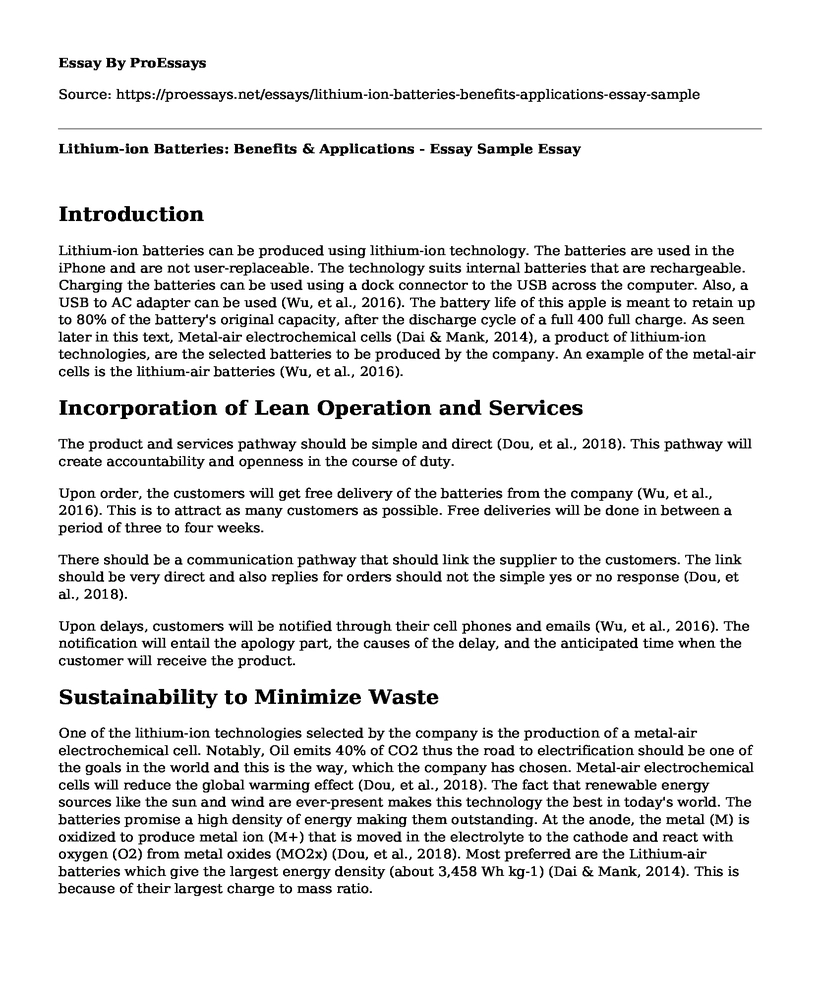Introduction
Lithium-ion batteries can be produced using lithium-ion technology. The batteries are used in the iPhone and are not user-replaceable. The technology suits internal batteries that are rechargeable. Charging the batteries can be used using a dock connector to the USB across the computer. Also, a USB to AC adapter can be used (Wu, et al., 2016). The battery life of this apple is meant to retain up to 80% of the battery's original capacity, after the discharge cycle of a full 400 full charge. As seen later in this text, Metal-air electrochemical cells (Dai & Mank, 2014), a product of lithium-ion technologies, are the selected batteries to be produced by the company. An example of the metal-air cells is the lithium-air batteries (Wu, et al., 2016).
Incorporation of Lean Operation and Services
The product and services pathway should be simple and direct (Dou, et al., 2018). This pathway will create accountability and openness in the course of duty.
Upon order, the customers will get free delivery of the batteries from the company (Wu, et al., 2016). This is to attract as many customers as possible. Free deliveries will be done in between a period of three to four weeks.
There should be a communication pathway that should link the supplier to the customers. The link should be very direct and also replies for orders should not the simple yes or no response (Dou, et al., 2018).
Upon delays, customers will be notified through their cell phones and emails (Wu, et al., 2016). The notification will entail the apology part, the causes of the delay, and the anticipated time when the customer will receive the product.
Sustainability to Minimize Waste
One of the lithium-ion technologies selected by the company is the production of a metal-air electrochemical cell. Notably, Oil emits 40% of CO2 thus the road to electrification should be one of the goals in the world and this is the way, which the company has chosen. Metal-air electrochemical cells will reduce the global warming effect (Dou, et al., 2018). The fact that renewable energy sources like the sun and wind are ever-present makes this technology the best in today's world. The batteries promise a high density of energy making them outstanding. At the anode, the metal (M) is oxidized to produce metal ion (M+) that is moved in the electrolyte to the cathode and react with oxygen (O2) from metal oxides (MO2x) (Dou, et al., 2018). Most preferred are the Lithium-air batteries which give the largest energy density (about 3,458 Wh kg-1) (Dai & Mank, 2014). This is because of their largest charge to mass ratio.
The Legal Involvement
Legally, the company will ensure all its workers in a registered insurance company against all the risks that the workers will get while undertaking their duties in the company (Dou, et al., 2018). Besides, the company will get a registration certificate from the government of the state.
The Cultural Involvement
Geographically, having been set in a society where there are people, the company will source 70% of its workers from the underlying society. This will help in improving the society's economic status and also make them realize the importance of the company in their society (Dai & Mank, 2014).
Human Involvement
Experts and qualified personnel from specific departments set in the company will be employed to aid in the production of the Lithium-ion batteries (Wu, et al., 2016). The personnel will help in realizing high-quality products.
Global Involvement
Concerning the global requirements, the company will uphold the non-CO2 emissions in its, production. The non-CO2 emission will help in be in-line with the 2050 carbon action plan (Dou, et al., 2018), set in the globe.
Conclusion
In conclusion, the Apple Company ought to produce Lithium-ion technology in their production of long-lasting batteries. The technology supports the Metal-ion electrochemical cell, which does not have the global warming effect in their production. Lithium-Air batteries have high charge ration and this makes them preferred.
References
Dai, H., & Mank, R. M. (2014). U.S. Patent No. 8,854,012. Washington, DC: U.S. Patent and Trademark Office.
Dou, X., Geng, C., Buchholz, D., & Passerini, S. (2018). Research Update: Hard carbon with closed pores from pectin-free apple pomace waste for Na-ion batteries. APL Materials,6(4), 047501.
Wu, L., Buchholz, D., Vaalma, C., Giffin, G. A., & Passerini, S. (2016). Applebiowastederived hard carbon as a powerful anode material for Naion batteries. ChemElectroChem, 3(2), 292-298.
Cite this page
Lithium-ion Batteries: Benefits & Applications - Essay Sample. (2023, Mar 07). Retrieved from https://proessays.net/essays/lithium-ion-batteries-benefits-applications-essay-sample
If you are the original author of this essay and no longer wish to have it published on the ProEssays website, please click below to request its removal:
- Should the Use Of Drones Be Banned? Essay Example
- Personal Internet Use and Risk Management Essay Example
- Use of Alternative Energy to Reduce Global Warming - Research Paper
- Essay Sample on AI and Its Impact on Commercial Recreation and Tourism
- Essay on Secure Mobile Devices: Protect Your Data & Information
- Essay Sample on Digital Revolution: Impact of Technology on Teenagers Worldwide
- Essay Example on Rising Cost of Healthcare: The Need for Innovative Solutions







